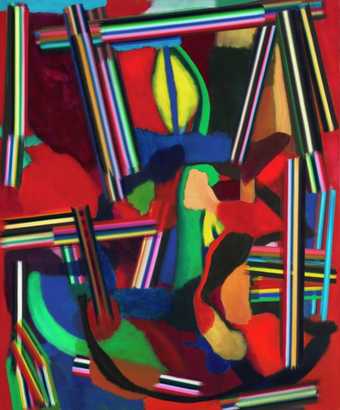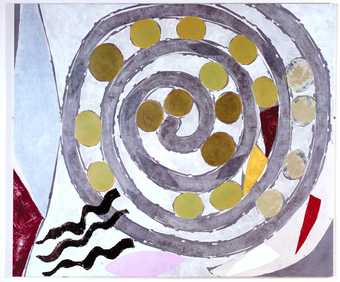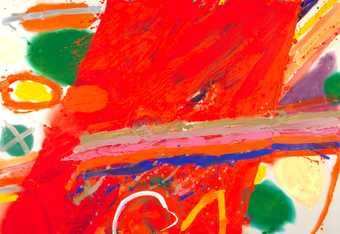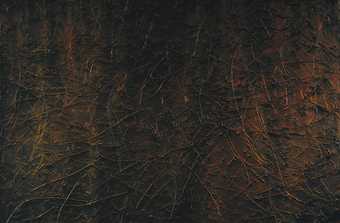
- Artist
- Sir Frank Bowling OBE RA born 1934
- Medium
- Acrylic paint and resin on canvas
- Dimensions
- Support: 1780 × 1360 mm
- Collection
- Tate
- Acquisition
- Purchased 2006
- Reference
- T12134
Summary
This work is part of a series of large scale acrylic paintings by Bowling that evoke places and moods without depicting specific landscapes. The title indicates that the painting relates to a visit Bowling made to Guyana with his son Sacha Jason in the spring of 1989. Bowling was born in Guyana in 1936 and emigrated to Britain in 1950. As Bowling explained in an interview with the art critic Mel Gooding, this was the first time Sacha Jason visited his father’s birthplace. Standing at the edge of the Demerara estuary in the Guyanese capital of Georgetown, looking out over the Atlantic Ocean, Bowling asked his son ‘to look over the sea wall to see whether what he could see had any connection with my painting’ (Gooding 2011, p. 115). Bowling recalled that his son had recognised in ‘this heat haze where everything looks flat, and with very little depth, what I had been trying to do with my art ... There it was, visible to any eye’ (Gooding 2011, p. 115). According to Bowling, the painting functions as a ‘record of [that] moment of realisation and confirmation’ (Gooding 2011, p. 115).
The surface of the work is richly textured; Bowling applied acrylic gels directly on to the canvas and reworked the paint with a spatula. This layering creates a rippling effect which alludes to the shifting patterns and tones of sunlight. It also gives the work a sculptural quality, as the repeated lines created by the edges of the spatula extend outwards from the canvas. These recurrent geometric shapes are combined with splashed patches of green, yellow and blue. A pink semicircular shape cuts across the left side of the canvas, visible through the modular squares rendered by the spatula, and is suggestive of the blurred light effects of a rising or setting sun on a body of water.
Bowling had worked in an entirely abstract mode since the early 1970s. By the late 1980s his work was becoming more expressive and demonstrated an increasing concern with the effects and qualities of light and the luminous potential of acrylic paints. The thick impasto and the concern with the reflective qualities of water and light reflects Bowling’s interest in the work of English landscape painters such as J.M.W. Turner and John Constable, as well as the beaches and salt-flats of coastal Guyana and the riverside locations of Bowling’s studios in London and New York.
Further reading
Mel Gooding, Frank Bowling, London 2011, pp.114–15.
Fiona Anderson
September 2013
Does this text contain inaccurate information or language that you feel we should improve or change? We would like to hear from you.
Display caption
In 1989 Bowling returned to Guyana with his son, Sacha. During this visit Bowling realised that his 1980s abstract paintings evoking the Thames and English landscape traditions, also referenced his birthplace. The light on the coastal mud banks of Guyana had apparently had an abiding, unconscious influence on his work. He asked Sacha to look over the sea wall in search of a connection to his painting. Sure enough, his son saw in ‘this heat haze where everything looks flat... what I had been doing in my art... there it was, visible to any ordinary eye’.
Gallery label, January 2022
Does this text contain inaccurate information or language that you feel we should improve or change? We would like to hear from you.
Explore
- abstraction(8,615)
-
- non-representational(6,161)
-
- colour(2,481)
- irregular forms(2,007)
- formal qualities(12,454)
-
- texture(466)















